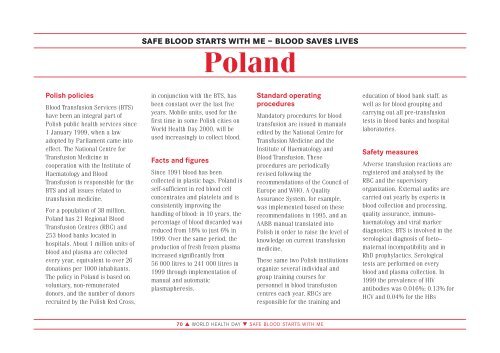Safe Blood Starts with Me - libdoc.who.int - World Health Organization
Safe Blood Starts with Me - libdoc.who.int - World Health Organization
Safe Blood Starts with Me - libdoc.who.int - World Health Organization
You also want an ePaper? Increase the reach of your titles
YUMPU automatically turns print PDFs into web optimized ePapers that Google loves.
SAFE BLOOD STARTS WITH ME – BLOOD SAVES LIVESPolandPolish policies<strong>Blood</strong> Transfusion Services (BTS)have been an <strong>int</strong>egral part ofPolish public health services since1 January 1999, when a lawadopted by Parliament came <strong>int</strong>oeffect. The National Centre forTransfusion <strong>Me</strong>dicine incooperation <strong>with</strong> the Institute ofHaematology and <strong>Blood</strong>Transfusion is responsible for theBTS and all issues related totransfusion medicine.For a population of 38 million,Poland has 21 Regional <strong>Blood</strong>Transfusion Centres (RBC) and253 blood banks located inhospitals. About 1 million units ofblood and plasma are collectedevery year, equivalent to over 26donations per 1000 inhabitants.The policy in Poland is based onvoluntary, non-remunerateddonors, and the number of donorsrecruited by the Polish Red Cross,in conjunction <strong>with</strong> the BTS, hasbeen constant over the last fiveyears. Mobile units, used for thefirst time in some Polish cities on<strong>World</strong> <strong>Health</strong> Day 2000, will beused increasingly to collect blood.Facts and figuresSince 1991 blood has beencollected in plastic bags. Poland isself-sufficient in red blood cellconcentrates and platelets and isconsistently improving thehandling of blood: in 10 years, thepercentage of blood discarded wasreduced from 18% to just 6% in1999. Over the same period, theproduction of fresh frozen plasmaincreased significantly from56 000 litres to 241 000 litres in1999 through implementation ofmanual and automaticplasmapheresis.Standard operatingproceduresMandatory procedures for bloodtransfusion are issued in manualsedited by the National Centre forTransfusion <strong>Me</strong>dicine and theInstitute of Haematology and<strong>Blood</strong> Transfusion. Theseprocedures are periodicallyrevised following therecommendations of the Council ofEurope and WHO. A QualityAssurance System, for example,was implemented based on theserecommendations in 1995, and anAABB manual translated <strong>int</strong>oPolish in order to raise the level ofknowledge on current transfusionmedicine.These same two Polish institutionsorganize several individual andgroup training courses forpersonnel in blood transfusioncentres each year. RBCs areresponsible for the training andeducation of blood bank staff, aswell as for blood grouping andcarrying out all pre-transfusiontests in blood banks and hospitallaboratories.<strong>Safe</strong>ty measuresAdverse transfusion reactions areregistered and analysed by theRBC and the supervisoryorganization. External audits arecarried out yearly by experts inblood collection and processing,quality assurance, immunohaematologyand viral markerdiagnostics. BTS is involved in theserological diagnosis of foeto–maternal incompatibility and inRhD prophylactics. Serologicaltests are performed on everyblood and plasma collection. In1999 the prevalence of HIVantibodies was 0.016%; 0.13% forHCV and 0.04% for the HBs70 ▲ WORLD HEALTH DAY ▼ SAFE BLOOD STARTS WITH ME

















